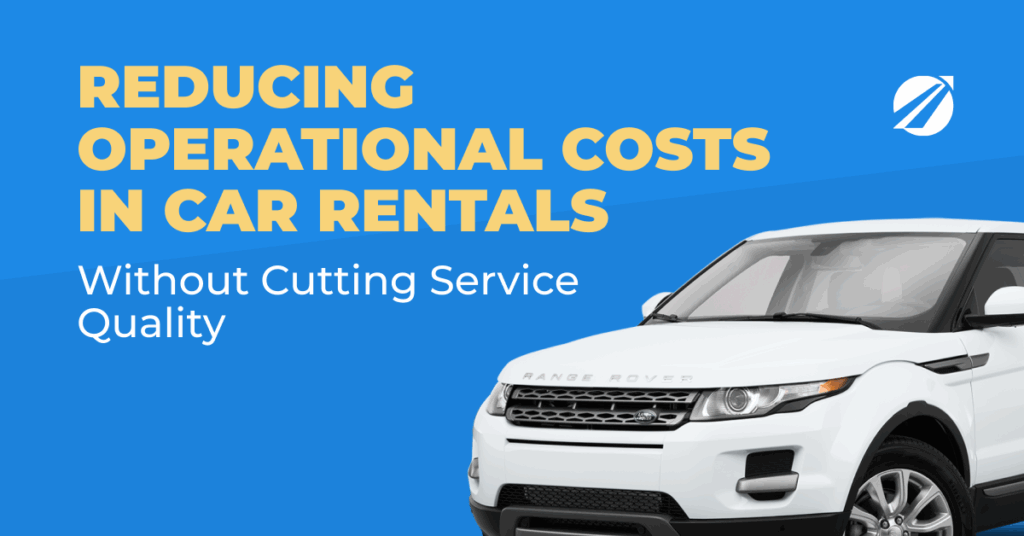
In 2025, independent car-rental operators face a double squeeze: costs are higher across the board — vehicles, insurance, parts, labor, software — while customers expect fast, digital, and immaculate service. Efficiency is no longer a competitive edge; it’s a survival requirement.
The goal isn’t to slash expenses but to optimize them. Cutting blindly slows handovers, frustrates teams, and erodes loyalty. Smarter operators automate repetitive work, rotate fleets deliberately, and let data guide every decision so that each euro, dollar, or kilometer creates visible value.
Customer behavior has also changed. Renters expect predictable experiences, instant confirmations, and consistent quality across locations. One missed pickup or unclear invoice now echoes through reviews and partner channels. Cost control and service quality are therefore the same discipline: design processes that keep standards high while removing waste.
This guide shows how to do exactly that. We unpack the true structure of operating costs and reveal where hidden leakages occur. We then cover practical levers — utilization, preventive maintenance, insurance discipline, staff workflows, and energy efficiency — and show how all-in-one software like TopRentApp provides real-time visibility, dynamic pricing, and automation without losing control.
Whether you run a single branch or a small network, the principles are constant: measure what matters, replace guesswork with data, and let technology handle the predictable so your team can focus on what customers notice most — speed, clarity, and trust. By the end, you’ll have a practical framework for a leaner, smarter, and more resilient operation that protects margins and scales sustainably.
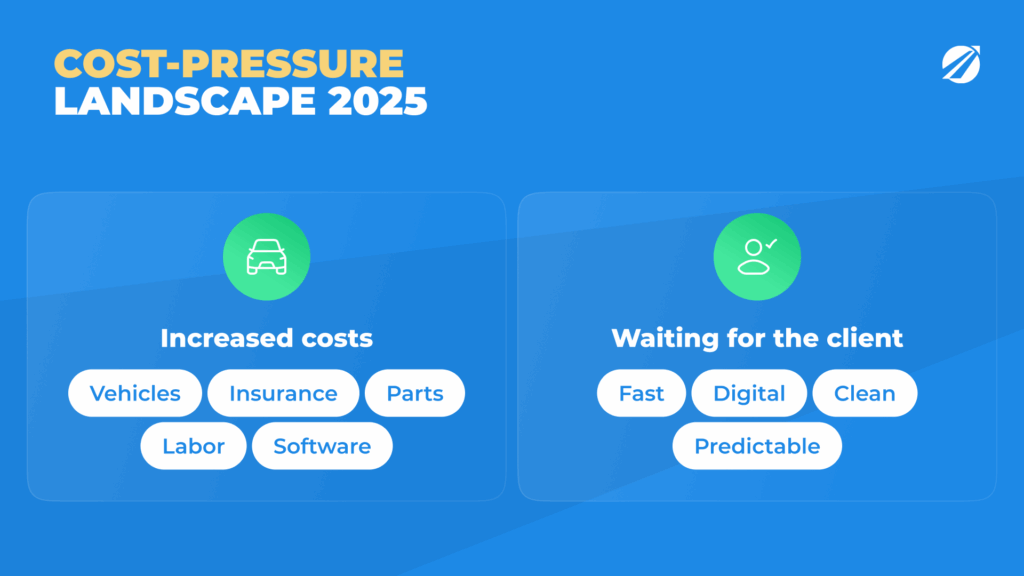
Understanding Operational Costs in Car Rentals
Before cutting expenses, operators need a clear picture not just of what they spend, but how those costs fluctuate with utilization, seasonality, and fleet age. Many rental businesses track totals — leases, payroll, fuel, insurance — but overlook the underlying mechanics. Once you see the cost engine clearly, optimization becomes precise rather than reactive.
Main Cost Categories

Fleet acquisition & depreciation
This is usually the largest cost — often 40–60% of total spend. Depreciation happens whether a car is rented or parked. Choosing models with stronger residual value, negotiating purchase terms, or using flexible leasing structures can shift profitability by several percentage points. TopRentApp’s fleet analytics help determine the right replacement moment, when rising maintenance and idle time outweigh residual value.
Maintenance & repairs
Typically, 6–10% of costs, but poorly planned maintenance can double this. Skipping a $150 service today may result in a $900 repair and days of downtime later. Preventive and telematics-based servicing turns emergency repairs into scheduled work, often reducing maintenance cost by 15–25% while keeping vehicles road-ready and customer complaints low.
Insurance & claims
Premiums have risen post-2022. Claims — even small ones — create downtime and admin load. Fleets that track damage digitally, settle claims efficiently, and use telematics-based driver oversight tend to secure better renewal terms and reduce claim frequency.
Staffing & payroll
The second-largest cost. The hidden expense is manual admin — paperwork, data entry, back-and-forth communication. Digital contracts, self-check-in, and automated billing often reduce admin time per booking by 20–30% while improving customer experience.
Technology, marketing & admin
Individually small, collectively meaningful. Running separate tools for reservations, invoicing, GPS, and CRM inflates software spend and lowers productivity. Consolidating these workloads in a single system increases visibility and reduces human error. Marketing should be measured by its effect on utilization, not just clicks.
Fixed vs Variable Costs

Fixed costs — leases, insurance, salaries, rent — remain constant whether 20% or 80% of the fleet is out. Variable costs — fuel, cleaning, commissions, mileage-dependent service — scale with usage.
If fixed monthly overhead is $20,000, then at 1,500 rental days it adds ~$13/day per vehicle; at 1,100 rental days, ~$18/day. Understanding this shift helps operators adjust pricing and promotions before margins tighten.
How Rising Costs Affect Profit Margins
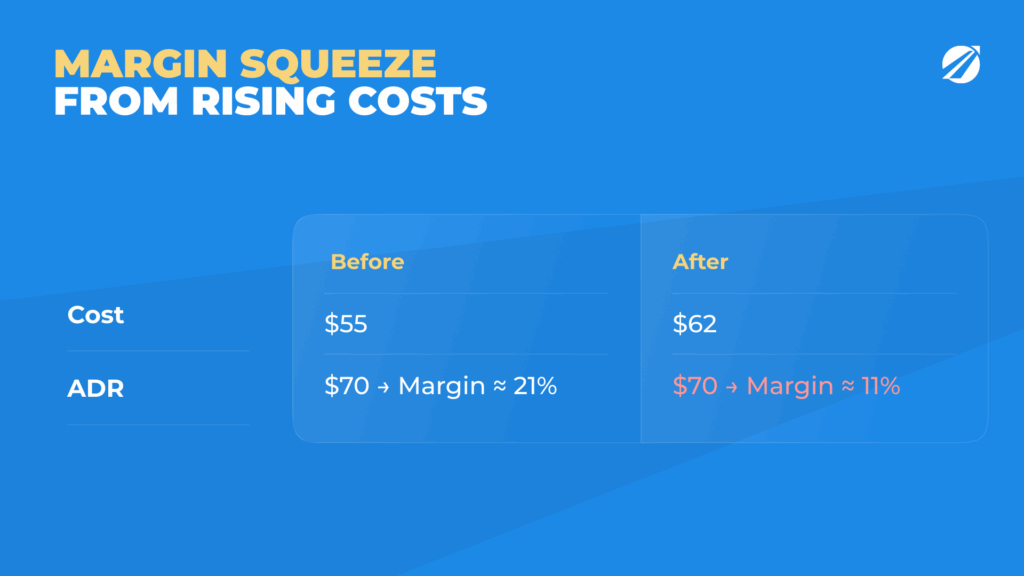
From 2023–2025, insurance rose 10–15%, financing rates increased, parts became pricier, and energy costs fluctuated. If daily operating cost rises from $55 to $62 while ADR stays at $70, margin shrinks from 21% to 11%. Operators must therefore balance:
- better utilization,
- stronger pricing discipline,
- and operational efficiency.
Cost control isn’t a one-time effort — it’s a continuous cycle of monitoring and adjustment. Operators who review their metrics weekly can react to early signals instead of discovering margin loss months later.
Framework for Cost Optimization
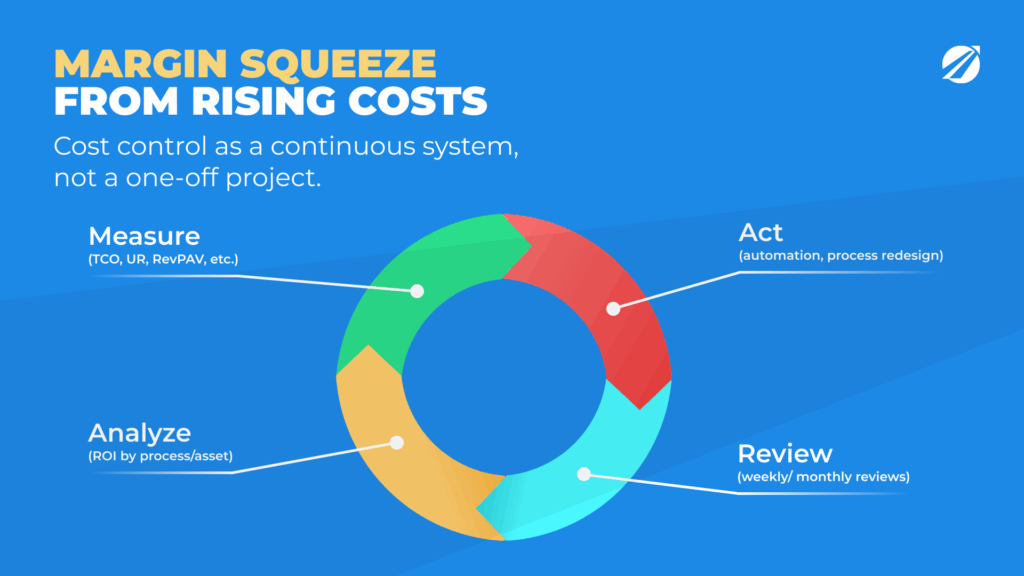
Cost control shouldn’t mean random cuts; it should follow a clear system — measure, analyze, act, and repeat. The best operators treat optimization as a continuous feedback loop that keeps every euro tied to customer value, utilization, or fleet health. Once that visibility exists, savings come naturally.
Step 1 — Identify and Measure
You can’t improve what you don’t measure.
Many operators know their total spend but not their cost per vehicle or per day, so inefficiencies stay hidden. Begin by calculating your Total Cost of Ownership (TCO) — including acquisition, depreciation, insurance, maintenance, and overhead — and then divide that figure by the number of paid rental days. That’s your real daily cost.
Example: if one car costs $12,000 a year and rents for 200 days, each idle day “costs” $60 in lost potential. Suddenly, a parked car becomes an expense, not just unused inventory.
Next, track Revenue per Available Vehicle (RevPAV) and Utilization Rate (UR). When monitored weekly, these metrics reveal early warning signs — low-demand branches, high idle time, or rising per-day costs.
Step 2 — Analyze ROI of Each Process
Once visibility improves, evaluate which costs create value. Ask:
- Does it enhance the customer experience?
- Does it reduce risk or downtime?
- Does it directly or indirectly raise revenue?
If not, it’s a candidate for redesign.
Take check-ins: manual ID verification and contract printing take ~6 minutes per booking. A digital self-check-in and e-signature take one minute. Across 8,000 bookings, that’s over 530 staff hours saved — about $10,000 annually — while improving customer speed and professionalism. Apply the same test to maintenance, insurance renewals, billing, and marketing.
Step 3 — Implement Efficiency Tools
Optimization means freeing people from repetitive work, not replacing them.
Automation tools like TopRentApp handle recurring workflows — invoices, maintenance reminders, vehicle status updates, deposits, and damage photos — allowing staff to focus on customers and quality.
Centralization also creates consistency: mileage triggers maintenance automatically, and pricing reacts to utilization instead of guesswork. When cost, booking, and fleet data live in one place, patterns appear — like which vehicles idle too long or which branches overspend on cleaning.
Over time, small adjustments compound: 5% cost reduction here, 3% higher utilization there, another 2% fewer breakdowns. Within months, those incremental gains turn into double-digit ROI improvements.
The result isn’t just lower costs — it’s calmer teams, faster response times, and a stronger reputation for reliability.
Fleet-Related Cost Reduction Strategies

The fleet is every rental company’s largest expense — and its greatest opportunity. Optimizing utilization, maintenance, insurance, and fuel efficiency turns cost centers into revenue engines. The goal isn’t to squeeze vehicles harder but to make each one earn its keep consistently.
Optimize Vehicle Utilization
Every idle day costs money. If your average daily ownership cost is $60, a week of inactivity equals $420 in lost profit. Instead of accepting utilization as a static KPI, use it as a steering tool.
Forecast demand using past bookings, travel calendars, and local events. Platforms like TopRentApp visualize this data and adjust rates or reallocate cars automatically. A Spanish operator boosted utilization from 72% to 79% in three months — adding 2,500 paid rental days and nearly $190,000 in extra revenue — without adding vehicles.
Dynamic pricing protects your margins. When utilization exceeds 85%, prices rise automatically; when it dips, discounts engage early enough to fill gaps.
Fleet rotation completes the picture: moving cars between branches quarterly balances mileage and prevents uneven wear, preserving resale value and predictable maintenance.
Preventive Maintenance Programs
If utilization drives revenue, maintenance protects it. Skipping scheduled service may save $150 today but cost $900 and five idle days later. Predictive maintenance powered by telematics transforms guesswork into planning, reducing unplanned repairs by 20–30%.
For a 100-car fleet earning $75/day, saving 20 idle days adds $150,000 annually — far exceeding the cost of telematics. Predictable scheduling also lets you shrink standby stock: cutting spare vehicles from 10% to 6% frees cash for growth instead of parking capital in unused cars.
Insurance Optimization
Insurance is both protection and profit drain. Standardizing coverage by class, adjusting deductibles for low-risk cars, and tracking claims digitally can cut premiums by 5–8%. Structured, photo-based workflows inside TopRentApp reduce disputes and admin time, while driver-behavior monitoring curbs risky habits.
Fleets combining telematics with safety training often see claims fall 15–20% in year one — and renewal discounts follow naturally.
Fuel and Energy Efficiency
Fuel remains volatile, but data brings control. Telematics data exposes inefficiencies like idling, harsh driving, or suboptimal routes — minor adjustments that can save up to 300 liters of fuel and €0–500 per vehicle annually.
Transitioning to hybrid or EV models adds structural savings. Though purchase prices are higher, running costs drop sharply: over three years, an EV driven 20,000 km annually can cost $4,000 less to operate than a gasoline car. A Lisbon operator that electrified 30% of its fleet cut fuel costs 40% and maintenance 25% within a year.
Connecting the Dots
Real efficiency happens when these levers work together. Demand forecasting improves pricing; predictive maintenance boosts uptime; insurance and telematics feed data back into fleet planning.
Even modest gains compound: Just a few operational gains — +4 pp utilization, two fewer idle days, and 8% less fuel consumption — can translate into up to €150K more profit per year for a 100-car fleet, achieved purely through better management.
Staff and Operations Efficiency
Fleet optimization gets most of the attention, but staffing and workflow efficiency often deliver quicker savings. In many rental businesses, small process inefficiencies quietly consume 20–30 % of the margin. When operations become structured and supported by automation, costs drop and service quality actually improves.
Streamlining Staff Workflows

Bottlenecks usually arise not from lack of effort, but from poorly designed routines. A front-desk agent might spend half the day verifying IDs, printing contracts, and re-entering data. Every repeated action is an automation opportunity.
Digital check-in and check-out turn paperwork into a two-minute process. Customers upload their license and ID in advance, so at pickup staff simply hand over the keys and collect a digital signature. A branch processing 25 rentals daily saves around 1.5 staff hours per day — almost 40 working days a year that can be redirected to sales or service.
Automated billing eliminates end-of-day reconciliation and reduces disputes. One Croatian operator using TopRentApp cut accounting overtime by 20 % and customer billing complaints by 35 %. Integrating communication — so every delivery, inspection, or return is logged automatically — further reduces delays and miscommunication.
Cross-Training and Role Flexibility
For small and mid-sized companies, flexibility is efficiency. Staff trained across multiple roles — reservations, delivery, inspection, and support — help keep operations efficient even with a lean team.
Cross-training just two of five employees for delivery tasks can eliminate the need for temporary hires, generating annual savings of roughly €12K while preserving operational continuity. Cross-trained teams also see the full rental cycle and spot workflow gaps earlier. Rotating roles weekly keeps skills fresh and morale high.
Some operators offer small bonuses for multi-skill proficiency — a low-cost investment that increases retention and teamwork.
Outsourcing and Partnerships
Not every task must be done in-house. Outsourcing cleaning, logistics, or certain marketing functions can reduce fixed costs if quality standards are enforced.
If internal cleaning averages $14 per car and a contractor guarantees the same result for $9, a 10 000-rental operation saves about $50 K per year. Service-level agreements with measurable KPIs protect consistency.
Partnering with local delivery or chauffeur services can expand door-to-door offerings without maintaining a separate logistics fleet. A Rome-based operator reduced transfer costs 40 % this way, while customers still perceived the experience as fully branded.
Creating a Culture of Efficiency
Tools alone don’t create efficiency — people do. When staff understand why processes change, they support them. Clear communication — “we’re automating check-in to reduce queues, not jobs” — turns skepticism into engagement.
Transparency reinforces that culture. Dashboards showing utilization, handover time, or NPS motivate teams through shared accountability. Many TopRentApp users use analytics not to monitor staff, but to recognize excellence and replicate best practices.
As repetitive work disappears, morale rises, errors fall, and operations stabilize. The result is a calm, predictable rhythm — faster for customers, lighter for employees, and healthier for margins.
Technology as a Cost-Cutting Enabler

Digital transformation is no longer optional — it’s the foundation of profitable rental operations. Technology doesn’t replace people; it multiplies their impact. When operators automate repetitive work, unify data, and make data-driven decisions, they lower operating costs and deliver faster, more reliable service.
Automation and Rental-Management Software
Automation starts with repetition. Tasks like creating bookings, sending confirmations, issuing invoices, and scheduling maintenance consume hundreds of hours a year when handled manually. One misplaced mileage entry or rate change can create expensive errors.
Integrating all workflows — reservations, billing, fleet tracking, and communication — into one system like TopRentApp eliminates duplication. Data updates everywhere instantly, removing version chaos and billing discrepancies.
A 150-vehicle operator saved about 1,200 staff hours annually after automating invoicing, maintenance reminders, and e-signatures — equivalent to one full salary. Instead of downsizing, the company reassigned that employee to manage B2B partnerships, turning efficiency into new revenue. Consistency also improved: pricing, contracts, and invoices now stay aligned automatically.
Using Data Analytics for Decision-Making
Data is only valuable when it drives action. Analytics expose where profit leaks — underperforming branches, high-maintenance vehicles, or inefficient staff workflows.
Example: two identical cars in different cities earn $1,900 and $1,350 monthly. Without analytics, the cause stays hidden. With dashboards, you can trace the gap — lower ADR, too much downtime, or local demand shifts — and adjust before it compounds.
Telematics and IoT
Modern telematics give every operator visibility once reserved for large fleets. Compact sensors track vehicle location, mileage, fuel use, battery health, and driving style in real time.
Knowing where each car is — and how it’s driven — reduces idle time, improves safety, and cuts fuel and maintenance costs by 10–15%. A 200-car operator in Eastern Europe lowered fuel spend 11% and maintenance 17% within six months after installing telematics.
When this data flows directly into TopRentApp, servicing schedules, pricing rules, and idle-time alerts update automatically. What was once “fleet tracking” becomes predictive management.
The Bigger Picture: Integration as Strategy
True efficiency comes from integration. When automation, analytics, telematics, work together, decisions become faster and consistent across the business. Operators can adapt to market shifts — fuel spikes, regulation changes, seasonal swings — within days, not months.
Digitization also stabilizes service quality. Customers experience the same speed and clarity regardless of who serves them, and managers rely on facts, not intuition. The paradox is simple: technology lowers costs by increasing consistency and trust.
Maintaining Service Quality While Cutting Costs
Cost reduction doesn’t have to mean sacrificing customer experience. In fact, smart optimization often improves it. The key is focusing on what customers actually notice — and removing the effort they never see.
Focusing on What Customers Actually Notice
Customers judge your brand by speed, clarity, cleanliness, and fairness — not by headcount or office size. These high-perception factors are often the cheapest to improve.
An automated SMS like “Your car is ready for pickup at counter 3” costs cents but cuts waiting complaints by 40%. Consistent cleanliness and transparent post-rental billing create more loyalty than expensive décor or branded merchandise.
A simple exercise helps: map every customer touchpoint (inquiry, booking, pickup, return) and score it by impact and cost. Invest where the emotional impact is high and the cost low. With TopRentApp’s feedback tools, you can see which steps customers mention most — and focus improvements there first.
Empowering Staff with Technology
Service quality depends on empowered staff. When employees have instant access to customer data, contracts, and vehicle status, they appear more confident and resolve issues faster.
For example, with integrated dashboards, agents can confirm future availability or modify reservations instantly, avoiding delays that frustrate customers. Equipping frontline staff with tablets for digital check-ins or photo inspections shortens queues and reduces errors.
A Lisbon operator introduced tablet-based check-ins through TopRentApp and cut average waiting time from seven minutes to three — while satisfaction scores rose 15 points without increasing staff hours. When tech removes friction, human interaction shines.
Using Customer Feedback to Guide Investment
Feedback isn’t just a survey — it’s operational intelligence. Many operators collect it but rarely analyze it. Modern systems like TopRentApp turn raw comments into actionable insights, highlighting what drives loyalty and what causes churn.
Operators often discover that small irritations — unclear fuel rules, deposit holds, slow refunds — hurt satisfaction more than big issues. Fixing these details can raise Net Promoter Score (NPS) by 10+ points at almost no cost.
Conversely, expensive “wow” elements like fancy lounges rarely affect loyalty. By tracking sentiment trends, you can invest where it matters: clarity, responsiveness, and transparency.
Consistency as the Ultimate Quality Indicator
Perfection isn’t required — consistency is. Customers forgive minor flaws if every interaction feels reliable and predictable. Automation supports this by eliminating chaos: vehicles are serviced on time, communication is uniform, and billing is transparent.
Consistency also reduces staff stress. Everyone knows the process, customers know what to expect, and managers can focus on improvement instead of firefighting. One regional operator put it best: “Before automation, we were good on good days and poor on bad ones. Now we’re consistently good — and customers notice.”
Turning Efficiency into Differentiation
In competitive markets, efficiency becomes part of your brand. Quick check-ins, clean vehicles, and precise communication feel premium to customers even when costs are lower. Efficiency isn’t about doing less; it’s about delivering better with the same resources.
Market leaders use this to their advantage — confidently promoting “fast pickup, transparent billing, zero surprises” as brand promises they can keep. Reliability builds loyalty faster than discounts ever could.
The Bottom Line
Cutting costs and improving service are not opposites. Both depend on structure and discipline. When every process — from booking to billing — is designed for clarity and speed, quality becomes a by-product of efficiency.
The result is a business that feels effortless to run and effortless to rent from — the essence of sustainable service excellence.
Managing Seasonality and Economic Downturns
Seasonality is the car-rental industry’s built-in challenge: busy summers, quiet winters, unpredictable shoulder months. The companies that thrive don’t fight it — they design their business around it. Flexibility, data visibility, and planning turn volatility into advantage. The same principles apply during broader economic slowdowns.
Adapting Fleet Size and Operations
Fleet flexibility is your best defense. Too many cars in low season drain profit; too few in high season limit revenue. The solution is a scalable structure — combining owned and short-term leased vehicles that can expand or contract with demand.
For example, a 100-car operator might own 70 vehicles and lease 30 seasonally. When demand slows, leases expire naturally without financial strain. Subleasing underused vehicles to corporate clients or mobility partners keeps utilization above 70% year-round.
Leveraging Low-Season Promotions
When bookings drop, cutting prices feels tempting but risky — discounts can permanently reset customer expectations. Instead, focus on value-based offers: “rent 3 days, get the 4th free,” or bundled upgrades like GPS or extra drivers. These boost utilization without hurting ADR.
A mid-sized operator in Nice ran a “Weekend Getaway” campaign combining flexible pickups and free upgrades. February utilization jumped from 54% to 69% — without long-term rate erosion.
Partnerships also amplify visibility at low cost. Hotels, airlines, and event organizers face the same seasonal troughs — co-marketing with them fills multiple gaps at once. Joint offers (“fly and drive,” “hotel + car discount”) share costs and attract quality leads.
Shifting target segments helps too. Tourists may disappear in winter, but corporate clients remain active. Long-term B2B contracts smooth cash flow and reduce marketing dependency. With TopRentApp’s corporate module, rates, invoicing, and mileage limits are automated for recurring business.
Diversifying Income Streams
Diversification stabilizes revenue when short-term rentals fluctuate. Three proven paths:
- Add-on services. Upselling insurance packages, prepaid fuel, or delivery boosts margins above 60%. Even a 10% increase in add-on uptake adds $20 per rental — $200K annually for 10,000 rentals.
- Long-term or subscription rentals. Monthly contracts with mileage caps attract customers who want flexibility without ownership. TopRentApp automates billing and utilization tracking for these models.
- Event rentals. Weddings, conferences, and productions bring bursts of high-margin demand. An operator near Lake Como built a wedding-rental division contributing 25% of annual revenue during off-peak months.
Financial Forecasting and Resilience
Seasonality exposes weak cash-flow management. Align large expenses — insurance renewals, licensing, fleet replacements — with high-revenue months. Use forecasting tools to simulate income versus cost cycles and set aside summer surplus as a dedicated low-season fund.
TopRentApp’s analytics model revenue curves and flag months where costs outpace income, prompting early action: resizing fleet, delaying purchases, or adjusting rates.
Navigating Economic Downturns
While seasonality is predictable, downturns aren’t — but the same preparedness helps. During the 2020–2021 crisis, companies with flexible leases, automated operations, and data visibility adapted fastest. They paused insurance, renegotiated payments, or pivoted to corporate and delivery rentals within weeks.
TopRentApp’s live dashboards and alerts provide this agility — allowing you to forecast, simulate “what-if” scenarios, and act before conditions worsen.
Turning Seasonality into Strategy
Slow months shouldn’t be dead months. Use them for training, maintenance, and marketing prep so your team and fleet start the next peak in top shape. With technology-driven visibility, seasonality becomes a rhythm, not a threat — and downturns become opportunities to innovate, not panic.
KPI Framework for Cost and Quality Balance
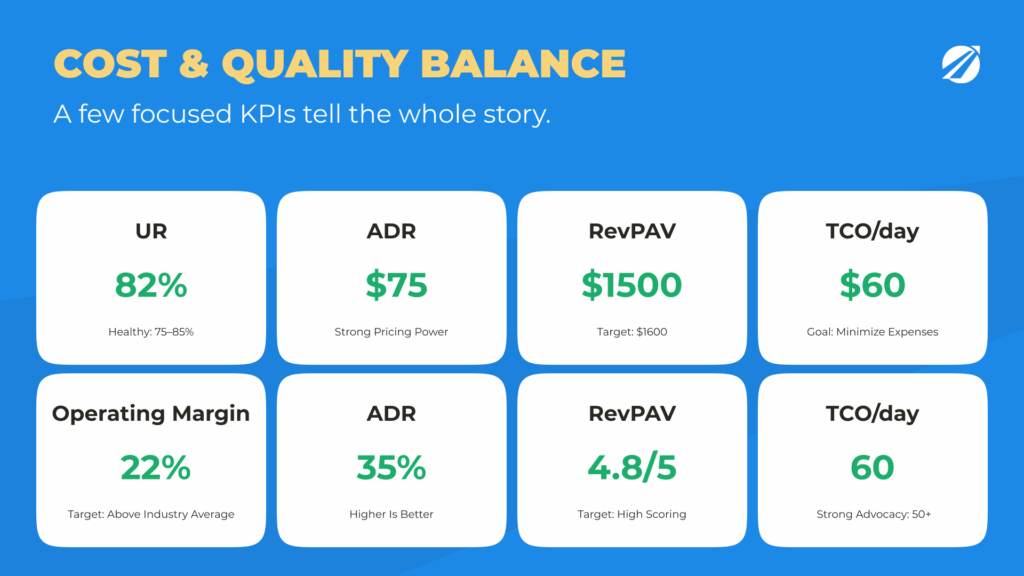
You can’t manage what you don’t measure. For car rental operators, numbers aren’t just reports — they’re navigation instruments. A focused KPI framework reveals where costs hide, where efficiency pays off, and whether savings harm or strengthen service quality. The goal is not endless metrics but a few that tell the whole story.
Utilization Rate (UR)
UR shows how effectively your fleet generates revenue:
UR = Rented days ÷ Available days.
A 100-car fleet with 2,400 rental days in a month achieves 80% utilization. If each car costs $60 per day to operate and earns $75 ADR, the business covers costs comfortably. Drop to 65%, and every idle day erodes margin.
Each operation’s break-even UR differs: lean fleets may survive at 65–70%, while high-overhead ones need 75%+. Tracking UR weekly — not monthly — exposes seasonal dips early. TopRentApp’s live utilization dashboards help managers react instantly through reallocation or short-term promos.
Average Daily Rate (ADR)
ADR measures pricing strength:
ADR = Total rental revenue ÷ Rental days.
A 5% ADR increase directly lifts profit. A fleet earning $1.5M yearly at $75 ADR adds $80K in revenue at $79 ADR — even with the same utilization. Yet raising ADR blindly can reduce bookings. Balance it with UR to sustain healthy Revenue per Available Vehicle (RevPAV).
Revenue per Available Vehicle (RevPAV)
RevPAV blends ADR and UR to show actual earning power:
RevPAV = Total revenue ÷ (Fleet size × Time).
It’s the most telling measure of fleet productivity. A 50-car fleet earning $300K in 100 days has $60 RevPAV. Comparing RevPAV across branches or segments reveals hidden inefficiencies — low demand, overpricing, or underused vehicles.
Total Cost of Ownership (TCO)
TCO captures the real cost of each vehicle over its lifecycle:
TCO = (Acquisition + Depreciation + Maintenance + Insurance + Admin) ÷ Time or Rental Days.
If a $30K car costs $3K yearly to maintain and runs four years, TCO is $42K total — about $875 per month or $60 per rental day.
If ADR minus variable cost doesn’t exceed TCO by 10–15%, pricing or cost structure needs review.
Operating Margin and ROI
Operating Margin = (Revenue – Operating Costs) ÷ Revenue.
Healthy operations maintain 15–25%. Falling below 10% signals pricing or cost inefficiency.
ROI = (Net Profit ÷ Total Investment) × 100.
Example: a $25K sedan generating $10K annual profit yields 40% ROI; an SUV costing $40K and earning $11K gives 27%. Tracking ROI by vehicle class helps fine-tune fleet composition based on facts, not perceptions.
Customer Satisfaction (CSAT) and Net Promoter Score (NPS)
Numbers describe today; satisfaction predicts tomorrow.
CSAT (1–5 rating) measures immediate experience.
NPS shows loyalty by asking, “Would you recommend us?” Scores above +50 signal strong advocacy; below +20 warn of retention issues.
Reading the Dashboard as a Story
Each KPI is a chapter; together they tell the business story.
- Rising ADR with flat RevPAV = overpricing.
- Falling UR but stable NPS = oversupply.
- High UR but dropping CSAT = staff or service strain.
The KPI Habit
Consistency matters more than perfection. Review key metrics weekly to catch slow drifts early. Over time, this rhythm builds a culture of accountability: teams see how daily actions shape results. When numbers and people move in sync, cost control becomes second nature — and service excellence follows automatically.
How Rental Management Software Helps Optimize Operations
Technology is the backbone of modern rental efficiency. The right system doesn’t just store data — it connects every part of the business: vehicles, staff, customers, and finance.
Automated Fleet Maintenance Scheduling
Maintenance delays are among the costliest inefficiencies in rental operations. TopRentApp automates service scheduling based on mileage, time, or usage data — preventing breakdowns before they happen.
Each vehicle’s status updates in real time; when a service is due, tasks are created automatically, with notifications sent to mechanics or partners. This keeps vehicles earning longer, reduces unplanned downtime, and supports consistent fleet health reporting.
Utilization and Profitability Dashboards
Profitability depends on visibility. TopRentApp’s dashboards consolidate UR, ADR, RevPAV, TCO, and ROI into one real-time view. Managers can see which vehicles underperform, which segments deliver the best margins, and how each branch contributes to overall results.
Instead of scattered spreadsheets, you get live answers to questions like: “Which cars are generating profit below target?” or “Which class needs rotation next month?” — all within seconds.
Staff Management and Workflow Automation
Staff efficiency drives service quality. TopRentApp automates daily workflows — from reservation assignment and contract generation to billing, deposits, and damage logging. Notifications ensure nothing falls through the cracks.
By reducing manual input, front-line staff can focus on customers rather than paperwork. One operator using TopRentApp’s automation suite saved more than 1,000 admin hours per year and used that time to expand its B2B client base.
Alerts for Cost Anomalies and Service Gaps
Real-time alerts detect anomalies — a sudden spike in cleaning cost, underutilized vehicles, or unusually high claim frequency. These insights allow managers to act immediately instead of waiting for end-of-month reports.
Alerts also flag customer experience gaps, such as low feedback scores or extended handover times. The system connects cost control directly to service quality — making it easier to fix problems before they affect reputation.
Common Mistakes to Avoid
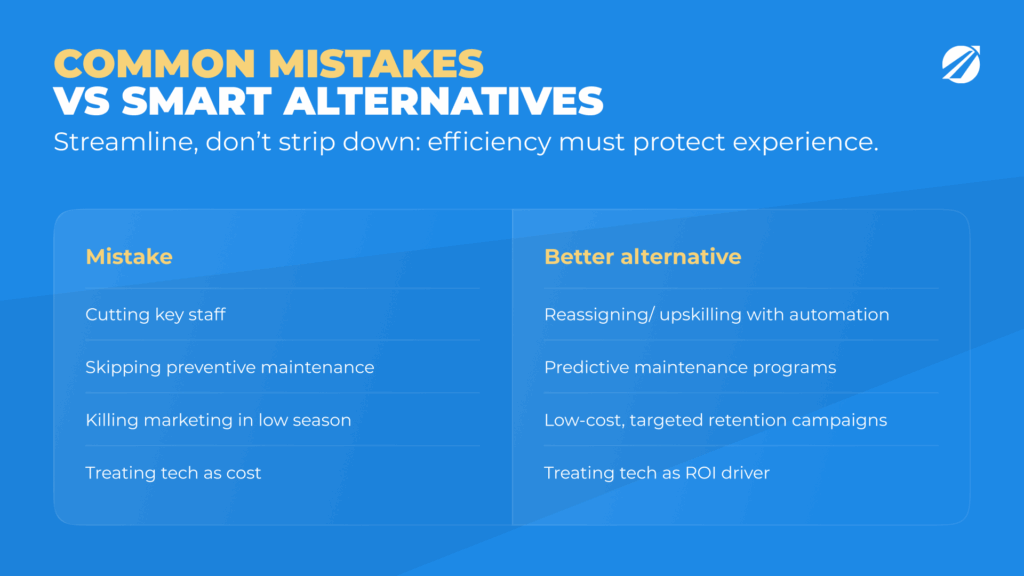
Cost reduction projects often start with enthusiasm but risk drifting into short-term thinking. The goal is to streamline, not to strip down. Below are the most frequent pitfalls rental operators encounter — and smarter alternatives that sustain both efficiency and service quality.
1. Cutting Key Staff Too Early
Payroll cuts seem tempting, but removing experienced front-line staff before workflows are automated can trigger chaos: longer queues, slower responses, and lower customer trust.
Instead, reassign and upskill. Once repetitive tasks are automated, staff can focus on higher-value work such as client relations or B2B sales. A Milan operator reduced admin hours by 25% but repurposed that time into lead management — revenue grew, costs fell, and morale stayed high.
2. Skipping Preventive Maintenance
Skipping service saves in the short term and costs heavily later. One breakdown can erase months of small savings through downtime, refunds, and bad reviews. Predictive maintenance with automated alerts reduces breakdowns by 20–30%, turning uncertainty into control.
3. Over-Reliance on Manual Tracking
Spreadsheets can’t run a modern fleet. Manual data entry hides inefficiencies until it’s too late. Operators using TopRentApp’s analytics often uncover thousands in avoidable costs — duplicate insurance, idle vehicles, billing errors — within weeks. Live dashboards replace “what happened” with “what’s happening now.”
4. Reducing Marketing During Slow Seasons
Turning off marketing in winter creates a recovery gap in spring. Keep visibility alive through targeted, low-cost channels: newsletters, SEO, partnerships, and remarketing to past customers. A Spanish operator paused ads but kept email campaigns; bookings dipped only 5%, and loyal customers returned stronger next season.
5. Treating Technology as an Expense
Software isn’t a cost — it’s a multiplier. Tools like TopRentApp save more than they cost by preventing manual errors, idle vehicles, and mispriced inventory. Reframing tech as an investment changes every decision: “How much will this feature earn or save me per car per day?” is a far healthier question than “What does this subscription cost?”
6. Neglecting Training and Staff Development
Automation doesn’t eliminate the need for human skill — it raises the bar. Skipping training causes costly mistakes and lower service consistency. Even a 20-minute onboarding video for new hires can prevent dozens of contract or inspection errors. Empowered staff make software more effective.
7. Forgetting the Customer Experience
Efficiency means nothing if it hurts the customer. Every cost decision should pass one test: Does this make life easier for the renter? If not, pause. Clean vehicles, fast responses, and transparent pricing cost less than fixing bad reviews later. Top operators never compromise what customers value most — predictability and trust.
The takeaway: Cost control and service quality are two sides of the same discipline. Avoiding these mistakes isn’t about perfection — it’s about balance. Efficiency that customers can feel is the only kind that lasts.
Conclusion — Smart Savings, Sustainable Growth

Reducing operational costs isn’t about cutting — it’s about aligning. When every euro supports utilization, customer satisfaction, or fleet health, efficiency becomes a growth strategy, not a survival tactic. The best-run operators don’t spend less — they spend smarter.
Over the past few years, data-driven fleets have proven that cost control and service excellence go hand in hand. Automation eliminates busywork, analytics expose hidden waste, and telematics turn guesswork into precision. The outcome: more uptime, faster service, and stronger margins with fewer resources.
The New Definition of Efficiency
Efficiency today means structure, not sacrifice.
When bookings are automated, customers experience speed.
When maintenance is predictive, vehicles stay reliable.
When staff are supported by smart tools, they deliver real hospitality instead of chasing paperwork.
This is the foundation of modern mobility — not less service, but better service with less waste.
Core Takeaways
- Know your numbers. Track TCO, UR, ADR, RevPAV, and ROI weekly — not monthly.
- Automate first. Replace repetitive admin with workflows that update in real time.
- Optimize your fleet. Rotate vehicles, predict demand, and replace at the right time.
- Empower your team. Automation frees people to focus on customers.
- Invest in visibility. The more you see, the faster you react.
Companies that internalize these principles turn efficiency into a competitive advantage. They grow steadily while competitors chase the next cost cut.
TopRentApp — Your Partner in Smarter Operations
Modern optimization requires visibility and control across every process. TopRentApp brings everything — fleet, reservations, billing, pricing, and analytics — into one platform.
It helps you:
- Automate bookings, invoicing, and maintenance reminders.
- Adjust pricing dynamically based on utilization.
- Track costs and profitability in real time.
- Eliminate manual errors while keeping service consistent.
Operators using TopRentApp typically see 10–20% lower overheads and higher customer satisfaction — not by working harder, but by working smarter.
A Future Built on Efficiency
As the rental industry evolves — electric fleets, flexible models, and AI pricing — one truth remains: efficiency is the new luxury. Companies that combine technology, data, and discipline won’t just survive downturns — they’ll lead the next growth wave.
Cost reduction becomes sustainable when supported by automation and accurate data.
👉 Request a free demo and explore how TopRentApp streamlines workflows and eliminates hidden inefficiencies.
A cost-optimization car rental software helps maintain service excellence while saving money.
